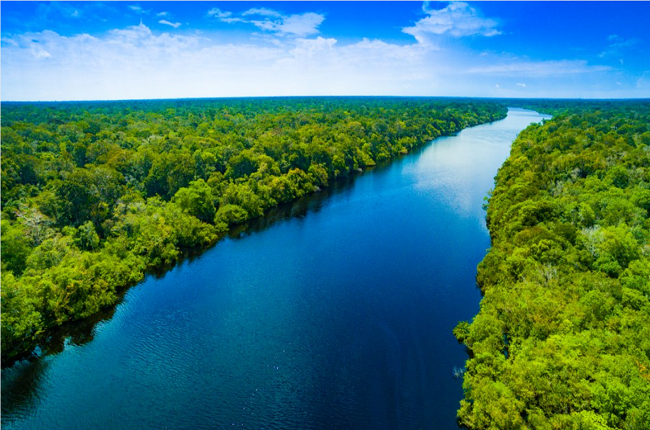The Longest River in the World is a subject that has sparked much debate among geographers and environmentalists alike. Historically, the Nile River was long considered the world’s longest, flowing across northeastern Africa and providing crucial support to the civilizations that developed along its banks. However, with the discovery of new tributaries and measurement methods, the Amazon River in South America has entered the conversation as a possible contender, even challenging the Nile’s longstanding dominance. In this article, we will explore five fascinating facts about the longest river in the world, shedding light on its geographical importance, role in local ecosystems, and ongoing debates surrounding its true length.
1. The Nile vs. The Amazon: Who’s Really the Longest?
For centuries, the Nile River held the title of the longest river in the world. It runs through 11 countries in northeastern Africa, from Lake Victoria in Uganda to the Mediterranean Sea in Egypt. The traditional measurement of the Nile’s length is around 6,650 kilometers (4,130 miles). This vast waterway has served as a lifeline for the civilizations of Egypt and Sudan, providing water, transport, and fertile soil for agriculture in an otherwise arid region.
However, the title of the longest river is no longer clear-cut. New studies and measurements of the Amazon River, particularly its tributaries like the Ucayali and Apurímac Rivers, suggest that it may actually exceed the length of the Nile. The Amazon River is the largest river by discharge and the second longest, but when new measurement methods are applied, some estimates suggest the Amazon stretches over 7,000 kilometers (4,345 miles), potentially making it the longest river in the world.
The debate remains unresolved, as the Amazon is trickier to measure due to its vast network of tributaries that can change with seasonal fluctuations. Moreover, the Amazon’s headwaters are located in the Andes Mountains, and mapping the exact source has proved difficult.
2. The Amazon: The Largest River by Discharge
While the Nile may hold the title for length (traditionally), the Amazon River is the undisputed leader when it comes to the volume of water it discharges. The Amazon River drains a staggering 215,000 cubic meters of water per second—that’s more than the next seven largest rivers combined!
This incredible flow makes the Amazon the lifeblood of the Amazon Rainforest, which is often referred to as the “lungs of the Earth” for its crucial role in absorbing carbon dioxide and producing oxygen. The river is fed by numerous tributaries, including the Madeira, Xingu, and Tapajós Rivers, which all converge to create the massive volume of water that flows to the Atlantic Ocean.
The Amazon River is not just a transportation route; it is also a crucial component of the world’s ecosystem. The rainforest and its river systems host some of the most diverse wildlife on the planet, from piranhas and pink dolphins to the elusive jaguar and countless species of frogs, birds, and insects.
3. Importance for Agriculture and Transportation
Rivers like the longest river in the world provide vital services to the regions through which they flow, supporting local economies and livelihoods. The Nile River, for example, has been a cornerstone of Egyptian agriculture for millennia. The river floods annually, depositing nutrient-rich silt that creates fertile land in an otherwise dry desert. This has allowed civilizations to flourish in the region, and even today, the Nile Delta remains one of the most productive agricultural areas in Egypt.
Similarly, the Amazon River plays a crucial role in the economy of Brazil and neighboring countries. Due to the vast size of the Amazon Basin, the river serves as the primary transportation route for people and goods. Remote areas of Peru, Colombia, and Brazil rely on riverboats and barges to transport everything from food to building materials.
- The Nile provides water for irrigation, supporting the agricultural economy of Egypt.
- The Amazon serves as a crucial trade route for the countries within its basin.
4. A Rich and Diverse Ecosystem
Both the Nile River and the Amazon River are home to a rich array of wildlife, though their ecosystems differ vastly due to the climates and geographical features surrounding them. The Amazon River is the most biodiverse river system on Earth. It is home to a staggering number of plant and animal species, many of which are endemic, meaning they are found nowhere else in the world.
The Amazon Rainforest itself is a global treasure trove of biodiversity. It contains more than 10% of the world’s known species, including the Amazon river dolphin, giant river otters, and anacondas. The biodiversity of the river is critical for sustaining both local communities and the wider environment, as it regulates the climate and contributes to the oxygen-carbon dioxide cycle.
In contrast, the Nile supports fewer species due to the more arid conditions surrounding the river. However, it still sustains a number of animals, such as the Nile crocodile, hippopotamus, and various species of birds. The Nile has been home to ancient wildlife for centuries, and many species in this region are considered to be culturally significant.
5. The Challenge of Measuring River Lengths
The debate over the longest river in the world is not just about measuring distances—it is about the challenges involved in defining what constitutes the “true” source and mouth of a river. Traditional measurements of the Nile River have been based on its most prominent source, Lake Victoria. But more recent studies consider other sources, including the Apurímac River in Peru, which some argue should be counted as the Amazon’s main source, stretching the river’s length by hundreds of kilometers.
Even the Nile’s measurement is not straightforward. While Lake Victoria is often cited as its source, some consider the river to start at Lake Tana in Ethiopia, which adds even more complexity to the debate. As a result, there is no universally accepted measurement for either river, and the question of which one is the longest depends on the criteria used to define the river’s course.
Longest river in the world facts
When learning about the longest river in the world, facts are crucial to understanding its incredible size and importance. This keyword focuses on the most interesting and lesser-known facts about rivers like the Nile and Amazon. You’ll find detailed comparisons of the river lengths, their historical significance, and unique environmental features. If you’re curious about the longest river in the world, this is an excellent starting point to gather accurate and engaging details about its influence across continents.
What is the longest river in the world 2024
The search for the longest river in the world often leads to comparisons between major rivers like the Nile and the Amazon. As of 2024, the debate continues about which of these two rivers holds the record. This keyword is perfect for those seeking the most current information and updated rankings of the longest river in the world. Whether you’re researching geography or planning your next travel adventure, this keyword brings valuable insights into river systems.
How long is the Amazon river compared to the Nile
The longest river in the world debate often involves comparisons between the Nile and the Amazon. This keyword helps users understand how the length of the Amazon River compares to the Nile River. With a focus on measurable river lengths, this topic delves into how each river’s length impacts its surrounding ecosystems. If you want to learn how the Amazon compares to the longest river in the world, this will offer clarity.
Longest river by length and discharge
The longest river in the world is not only determined by length but also by discharge. This keyword investigates how rivers like the Nile and Amazon are ranked not only by their length but also by the volume of water they carry. Understanding both aspects helps clarify why these rivers are so significant. For those interested in the combined factors of length and discharge, this content is a must-read.
Rivers longer than Nile
While the longest river in the world has traditionally been the Nile, there are rivers that challenge its status when considering certain criteria. This keyword focuses on lesser-known rivers that may be longer or comparable to the Nile, like the Amazon. Exploring rivers longer than the Nile broadens your understanding of the geographical giants on Earth. If you’re interested in discovering these rivals, this will give you insightful details about their lengths and significance.
Frequently Asked Questions (FAQs)
1. Which river is the longest in the world?
The title of the longest river in the world is contested between the Nile River and the Amazon River, with some estimates suggesting the Amazon could be longer than the Nile.
2. Why is the Amazon River so important?
The Amazon River is essential for maintaining global biodiversity, regulating the climate, and supporting millions of people who live in its basin.
3. How long is the Nile River?
The Nile River is traditionally measured at 6,650 kilometers (4,130 miles), although some newer studies may suggest different figures.
4. How long is the Amazon River?
The Amazon River is estimated to be over 6,400 kilometers (3,980 miles), but some newer measurements suggest it could be even longer, making it a possible contender for the longest river title.
5. How does the length of a river get measured?
Rivers are measured based on their total length, including their primary and secondary tributaries, which can vary depending on different measurement methods. This is why determining the longest river is often a matter of how the river’s source and mouth are defined.
Conclusion
In the ongoing debate about the longest river in the world, both the Nile River and the Amazon River hold special significance in their own right. While the Nile has been central to the rise of ancient civilizations and continues to support modern Egypt, the Amazon boasts unparalleled biodiversity and plays a crucial role in the world’s climate system.
Ultimately, the conversation surrounding the longest river is not just about the lengths of these rivers, but also about the importance they hold for human history, agriculture, and the environment. As we continue to measure, explore, and learn more about these incredible waterways, it’s clear that they are vital lifelines to the world we live in.
For those interested in learning more about world events and global celebrations, don’t miss the Auguri di Buon Anno 2025, as it offers a fascinating look at how people around the world celebrate the New Year!
You May Also Like:
Mensagem de bom dia para WhatsApp: 7 Powerful Ways to Inspire











